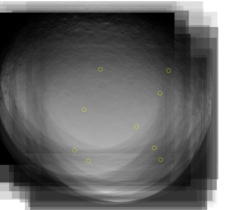QUOTE (Bjorn Jonsson @ May 21 2015, 07:42 PM)

I'm not exactly happy if I turn out to be right but the Dawn team now seems to think the bright stuff might be ice as I have been suspecting (comparisons to Callisto played a role there in my case). Something else causing the bright spots would have been more exciting.
It would be relatively 'ho-hum' if the bright areas had a Callisto-like distribution across Ceres, but these are so.... isolated. This could indicate:
1. There are scattered formations of the bright stuff below the surface that occasionally get exposed by impacts or landslides. These could be vein swarms, dikes, diapirs, or otherwise some kind of filled conduits or intrusive structures.
2. The bright stuff is more extensive beneath the surface, but it rapidly fades after being exposed by impacts or landslides. Such events would have to have happened in the (relatively) *very* recent past.
3. Some combination of 1 and 2. Edit: In either case, the original formations/structures could have been disrupted by subsequent impacts, and some of the smaller spots could be from large megabreccia clasts.
4. The bright stuff was deposited on the surface. This could be erupted flows of ice, salt deposits left after sublimation of brine, or who knows. Such deposits could fade over time as well.
(5. Other processes that I can't think of at the moment.)
To me, the fact that the bright area is so isolated, but yet is made up of smaller, scattered spots of varying sizes, seems to indicate that something quite interesting is going on here. 'Mundane' impacts or landslides exposing extensive but rapidly fading material -- the most 'boring' possibility -- seem to be less likely (unless the impact or slide was complex, e.g. disrupted rubble-pile meteoroid, as mentioned in posts above).
A question that will be answered soon: Are the bright spots on a surface that is smooth & flat, rough, or a combination? That should narrow down the possibilites once the slightly higher-res images come in. A (possible) fracture/valley in the midst of the spots could be dramatic indeed.






